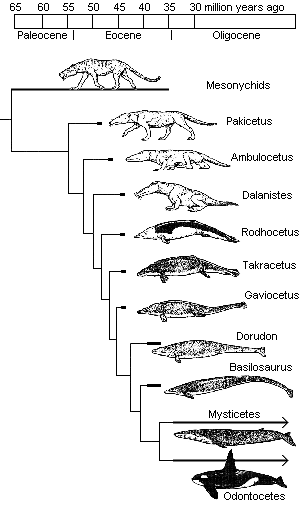 MSNBC.com is reporting on the discovery of a jawbone of an ancient whale in Antarctica: the oldest fully aquatic whale yet discovered. The news story reports,
MSNBC.com is reporting on the discovery of a jawbone of an ancient whale in Antarctica: the oldest fully aquatic whale yet discovered. The news story reports,
The jawbone of an ancient whale found in Antarctica may be the oldest fully aquatic whale yet discovered, Argentine scientists said Tuesday.
A scientist not involved in the find said it could suggest that whales evolved much more quickly from their amphibian precursors than previously thought.
Argentine paleontologist Marcelo Reguero, who led a joint Argentine-Swedish team, said the fossilized archaeocete jawbone found in February dates back 49 million years. In evolutionary terms, that’s not far off from the fossils of even older proto-whales from 53 million years ago that have been found in South Asia and other warmer latitudes.
Those earlier proto-whales were amphibians, able to live on land as well as sea. This jawbone, in contrast, belongs to the Basilosauridae group of fully aquatic whales, said Reguero, who leads research for the Argentine Antarctic Institute.
“The relevance of this discovery is that it’s the oldest known completely aquatic whale found yet,” said Reguero, who shared the discovery with Argentine paleontologist Claudia Tambussi and Swedish paleontologists Thomas Mors and Jonas Hagstrom of the Natural History Museum in Stockholm.
Paul Sereno, a University of Chicago paleontologist who wasn’t involved in the research, said that if the new find withstands the scrutiny of other scientists, it will suggest that archaeocetes evolved much more quickly than previously thought from their semi-aquatic origin in present-day India and Pakistan.
“The important thing is the location,” Sereno said. “To find one in Antarctica is very interesting.”
As many readers will doubtless be aware, the evolution of the whale has previously raised substantial problems because of the extremely abrupt timescale over which it occurred. Evolutionary Biologist Richard von Sternberg has previously applied the population genetic equations employed in a 2008 paper by Durrett and Schmidt to argue against the plausibility of the transition happening in such a short period of time. Indeed, the evolution of Dorudon and Basilosaurus (38 mya) from Pakicetus (53 mya) has been previously compressed into a period of less than 15 million years.
Previously, the whale series looked something like this:
Such a transition is a fete of genetic rewiring and it is astonishing that it is presumed to have occurred by Darwinian processes in such a short span of time. This problem is accentuated when one considers that the majority of anatomical novelties unique to aquatic cetaceans (Pelagiceti) appeared during just a few million years – probably within 1-3 million years. The equations of population genetics predict that – assuming an effective population size of 100,000 individuals per generation, and a generation turnover time of 5 years (according to Richard Sternberg’s calculations and based on equations of population genetics applied in the Durrett and Schmidt paper), that one may reasonably expect two specific co-ordinated mutations to achieve fixation in the timeframe of around 43.3 million years. When one considers the magnitude of the engineering fete, such a scenario is found to be devoid of credibility. Whales require an intra-abdominal counter current heat exchange system (the testis are inside the body right next to the muscles that generate heat during swimming), they need to possess a ball vertebra because the tail has to move up and down instead of side-to-side, they require a re-organisation of kidney tissue to facilitate the intake of salt water, they require a re-orientation of the fetus for giving birth under water, they require a modification of the mammary glands for the nursing of young under water, the forelimbs have to be transformed into flippers, the hindlimbs need to be substantially reduced, they require a special lung surfactant (the lung has to re-expand very rapidly upon coming up to the surface), etc etc.
With this new fossil find, however, dating to 49 million years ago (bear in mind that Pakicetus lived around 53 million years ago), this means that the first fully aquatic whales now date to around the time when walking whales (Ambulocetus) first appear. This substantially reduces the window of time in which the Darwinian mechanism has to accomplish truly radical engineering innovations and genetic rewiring to perhaps just five million years — or perhaps even less. It also suggests that this fully aquatic whale existed before its previously-thought-to-be semi-aquatic archaeocetid ancestors.
Another day; another bad day for Darwinism.
